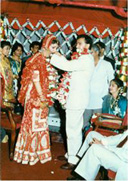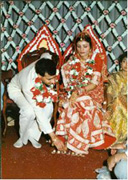 Horoscope Matching(sample)
Horoscope Matching(sample) |
 Melapak Report
Melapak Report |
 Astrology Services
Astrology Services |
 Astrology Books
Astrology Books |
 Aryabhatt Shopping
Aryabhatt Shopping |
 Shaadi Muhurats
Shaadi Muhurats |

|
|
|
|
|
|
|
The Wedding Ceremony of the Gujratis
 Introduction
Introduction
Gujarat provides variations to the vedically prescribed
Hindu wedding. From grabbing the grooms nose to stealing the grooms shoes, we
follow the rituals.
The Hindu engagement, Sangeet and mehndi ceremonies are all carried over to the Gujarati
wedding. However, after the groom's baaraat, the Gujarati wedding takes on a
more distinct flavour.
The Wedding Ceremony
The groom is welcomed to the mandap by his future
mother-in-law. As she welcomes him, the bride’s mother will try to grab the groom’s nose.
This tradition reminds the groom that during his courtship, he came rubbing his nose at
the family door asking for the bride’s hand. The groom’s feet are then ritually washed in a
ceremony called madhuparka.
 Seizing the opportunity, the bride’s sisters
will likely steal the groom’s shoes, redeemable after the ceremony for a nominal
fee. It is not known if Gujratis or Bengalis originated this tradition. Prior to
entering the mandap, the groom may or may not see his bride. In some
communities, when the couple are allowed to meet, they exchange garlands. The
groom, in this garland ceremony (jaimala), is elevated above the bride. In
antiquity, this elevation was meant to show the superiority of the groom.
Nowadays, the practise has been kept for the sake of tradition.
Seizing the opportunity, the bride’s sisters
will likely steal the groom’s shoes, redeemable after the ceremony for a nominal
fee. It is not known if Gujratis or Bengalis originated this tradition. Prior to
entering the mandap, the groom may or may not see his bride. In some
communities, when the couple are allowed to meet, they exchange garlands. The
groom, in this garland ceremony (jaimala), is elevated above the bride. In
antiquity, this elevation was meant to show the superiority of the groom.
Nowadays, the practise has been kept for the sake of tradition.
The
bride is carried or led into the mandap by her maternal uncle. The couple is
seated, separated by an antarpat (curtain), as the pundit opens the ceremony
with his blessings. The antarpat is then raised and the couple garlands each
other.
A Gujarati wedding from this point follows closely to a standard
Hindu wedding with several key additions and variations. Firstly, the elders of
the respective houses will tie cords around the bride and groom’s necks, warding
off evil spirits in a Varmala ceremony. Secondly, Gujarati weddings feature a
variation to sapta padi. Instead of the seven northward steps that are
associated with the seven promises, the groom helps the bride touch seven betel
nuts with her right toe. Sapti Padi is followed by a variation of Ashirvachan
called Saubhagyavati, in which married women pass by the couple whispering into
the bride’s right ear. When the bride’s mother passes, the groom will tug at her
sari. In the past this tradition called chero pakarvo, was a way for the groom
to ask the bride's family for the gifts or dowry he was owed as part of the
marriage.
A Gujarati wedding ends with Ashirwaad and the couple
depart.
After the Wedding
At the groom’s house the couple play
a game of aeki-beki. A tray or pot of water is tinted with milk and vermilion.
Inside the vessel, a ring and a few coins are placed. Both bride and groom get
seven attempts to find the ring. The first one to find the ring four times is
said to rule the household.
|
|


 Introduction
Introduction Seizing the opportunity, the bride’s sisters
will likely steal the groom’s shoes, redeemable after the ceremony for a nominal
fee. It is not known if Gujratis or Bengalis originated this tradition. Prior to
entering the mandap, the groom may or may not see his bride. In some
communities, when the couple are allowed to meet, they exchange garlands. The
groom, in this garland ceremony (jaimala), is elevated above the bride. In
antiquity, this elevation was meant to show the superiority of the groom.
Nowadays, the practise has been kept for the sake of tradition.
Seizing the opportunity, the bride’s sisters
will likely steal the groom’s shoes, redeemable after the ceremony for a nominal
fee. It is not known if Gujratis or Bengalis originated this tradition. Prior to
entering the mandap, the groom may or may not see his bride. In some
communities, when the couple are allowed to meet, they exchange garlands. The
groom, in this garland ceremony (jaimala), is elevated above the bride. In
antiquity, this elevation was meant to show the superiority of the groom.
Nowadays, the practise has been kept for the sake of tradition.